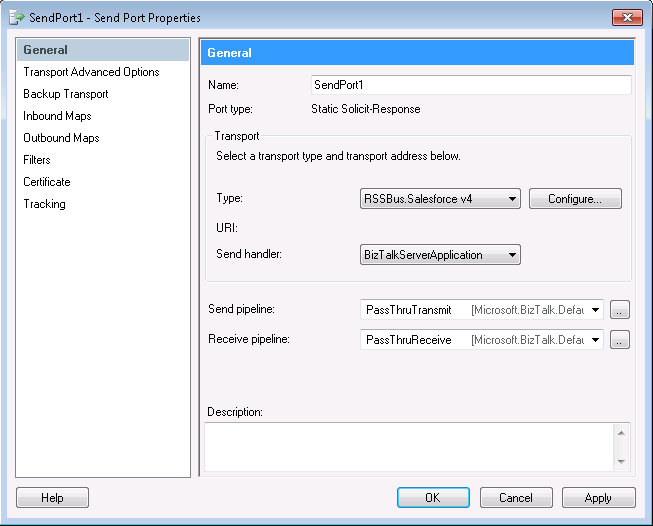Discover how a bimodal integration strategy can address the major data management challenges facing your organization today.
Get the Report →Configure a Solicit-Response Send Port for the CData BizTalk Adapter for Sage US
Use the adapter for Sage US with a solicit-response send port to execute updategrams and data manipulation SQL in BizTalk.
This section provides step-by-step instructions for creating, configuring, and testing a static solicit-response send port using the CData BizTalk Adapter for Sage US. You can use a static solicit-response send port to execute commands and access the results in BizTalk. You can use send ports to execute updategram commands, SQL commands, and stored procedure operations.
Create and Configure the Send Port
Create a static solicit-response send port and configure it to use the adapter as its transport type.
- If you have not already done so, open your BizTalk application in the BizTalk Administration Console.
- In the node for your BizTalk application, right-click Send Ports and select New -> Static Solicit-Response Send Port. The Send Port Properties dialog is displayed.
- In the Send Port properties, enter a name for the receive port.
- In the Transport Type menu, select CData.Sage50US;.
- In the Send pipeline menu, select the default option, PassThruTransmit.
- In the Receive pipeline menu, select the default option, PassThruReceive.

Configure the Adapter
Define the command the adapter will execute in the Transport Properties dialog.
- In the send port properties, click the Configure button. The Adapter Transport Properties dialog is displayed.
- In the CommandType property, select the command type you want.
- If you want to execute an SQL command, enter the command in the SQL Command box.

Configure the Connection to Sage US
Configure credentials and other properties required to connect to Sage US in the Connection String Options dialog.
- In the send port properties, click Configure. The adapter properties dialog is displayed.
- Click the button in the Connection String property. The Connection String Options dialog is displayed.
- Enter the connection properties. Below is a typical connection string:
ApplicationId=8dfafu4V4ODmh1fM0xx;CompanyName=Bellwether Garden Supply - Premium;The Application Id and Company Name connection string options are required to connect to Sage as a data source. You can obtain an Application Id by contacting Sage directly to request access to the Sage 50 SDK.
Sage must be installed on the machine. The Sage.Peachtree.API.dll and Sage.Peachtree.API.Resolver.dll assemblies are required. These assemblies are installed with Sage in C:/Program Files/Sage/Peachtree/API/. Additionally, the Sage SDK requires .NET Framework 4.0 and is only compatible with 32-bit applications. To use the Sage SDK in Visual Studio, set the Platform Target property to "x86" in Project -> Properties -> Build.
You must authorize the application to access company data: To authorize your application to access Sage, restart the Sage application, open the company you want to access, and connect with your application. You will then be prompted to set access permissions for the application in the resulting dialog.
While the compiled executable will require authorization only once, during development you may need to follow this process to reauthorize a new build. To avoid restarting the Sage application when developing with Visual Studio, click Build -> Configuration Manager and uncheck "Build" for your project.
- Click Test Connection to verify the values and test connectivity.
 The updategram tutorial for the adapter for Sage US walks through the steps to create a simple application that uses a solicit-response send port to execute an insert updategram to Sage US.
The updategram tutorial for the adapter for Sage US walks through the steps to create a simple application that uses a solicit-response send port to execute an insert updategram to Sage US.






